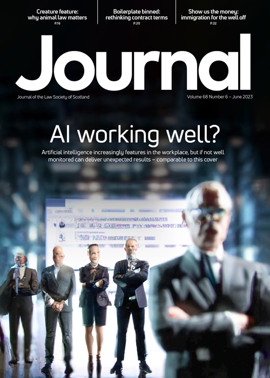Rethinking those ts and cs

 When it comes to contract drafting, are you a boilerplate welder? Do you include numerous clauses because you always do, without considering whether they serve a purpose, or even make much sense?
When it comes to contract drafting, are you a boilerplate welder? Do you include numerous clauses because you always do, without considering whether they serve a purpose, or even make much sense?
If so, you may find that the world is starting to move on.
Two separate work streams pursuing a different approach came together recently at a Law Society of Scotland round table. One involves a project by English firm Browne Jacobson, which for several years has worked with linguistics experts at the University of Nottingham to identify issues with traditionally complex insurance documents and devise ways to improve them. In the other, the Outsourcing, Technology & IP in-house legal team at NatWest is taking a fresh look at its business-to-business outsourcing contracts, including reviewing them from a neurodiversity angle. With these different drivers, they have found much common ground about what works best.

It was a connection made through the O Shaped programme – designed to develop lawyers who are human-centric as well as technically capable (see Journal, October 2022, 36) – that brought the two together. Browne Jacobson’s Claire Stripp, a member of the programme’s steering board, heard of work being done by Leigh Kirkpatrick (pictured), managing legal counsel in the NatWest team, and introduced her colleague Tim Johnson (pictured), who leads the firm’s insurance policy drafting and distribution team.
Only with a degree?
Browne Jacobson’s work with the linguistics specialists was revealing. “We found that on average insurance policies needed an undergraduate level of education to understand them”, Johnson recalls. “Some of them required doctorate levels. Comprehension was poor for real customers given questions with real life scenarios related to the product they were buying, about whether they were covered and so on.
“On the plus side, working with the linguistics professors we were able to identify very specific drafting techniques to improve readability and comprehension, and by deploying these we were able to reduce the reading age in some cases by 10 years, to wording that could be understood by a typically literate year 7 student. The impact of this in real terms is huge – it’s the difference between 13% of the UK adult population being able to understand a wording and approximately 85%, which is an improvement of over 40 million people.”
While the study focused on policy wordings for small businesses, the findings are very similar in policies designed for individuals, as well as those for larger businesses.
“A contract is a contract and there’s not really a huge difference in the insurance market between the complexity of consumer facing contracts and business to business contracts”, Johnson observes. “They generally follow a similar form and format, maybe a few more colours and images on the consumer facing ones, but the language is still complex in most cases.”
Kirkpatrick highlights both a professional and a consumer benefit from contract simplification. “One angle is making contracts more accessible or ‘readable’ for users, but the other angle is making them more accessible for lawyers, and in turn making the legal profession more accessible for people who are neurodiverse. Taking out unnecessary complexity in legal documents is a win-win.”
Subtle changes
Turning to what the linguistics team recommended, the perhaps obvious points like bulleted lists and numbered subparagraphs are only the start. “It’s about only having one idea per sentence – not dealing with multiple concepts”, Johnson explains. “It’s also about giving the reader agency: instead of talking about the insurer and the policyholder, talking about ‘we’ and ‘you’. It’s about how you word certain obligations – you can either say, we won’t make a payment unless you do x, y, z, or you can say, you must do x, y, z, or we won’t pay a claim. The second version led to considerably better comprehension, and better results on eye tracking tests. The first one people had to read twice; with the second they generally only had to read once. So there were some quite subtle things that would make a real difference.
“Then we did word frequency analysis. We would make a list of the lowest frequency words in the document [those least used in common speech] and remove as many as we could. Generally we found there might be some technical words in policies that have to be there, say in medical malpractice wording, but even in that situation at least 70-80% of low frequency words can usually be replaced with simpler, more everyday language.
“There’s also quite a lot around how you present the document to the customer. You can take a block of text, and without changing a single word or piece of punctuation, you can lay it out differently on the page and achieve better engagement. Using eye-trackers, we could track how customers found their way from the contents page and moved between definitions and the main part of the wording. Much work can be done around layout and presentation, as well as the actual words.”
Kirkpatrick follows up with other guidelines her team found helpful. “People often talk about drafting and legal design in the abstract, for example the benefit of using short sentences. ‘Short’ is quite subjective, so we set drafting design principles for our supply contracts, which among other things, set our ideal sentence as being no longer than 26 words. The same with spacing: the more white space in a document, the better, and the more subheadings, the easier a document is to navigate and digest.
All of these ‘invisible’ legal design elements make contracts easier for anyone to engage with, but are particularly helpful for those who are neurodiverse.”
Leaner and fitter
Both found themselves adopting what Kirkpatrick calls “clause clustering”. For example, to find out whether an item is insured against theft, you might have to check four or five different parts of your policy. “That absolutely kills comprehension”, Johnson states. “You want to be able to find the relevant page and see everything on that page.” That may mean repeating the same thing in different parts of the policy, but “We have always been able to shorten wordings despite that, because the simplification process usually results in more being taken out than is added.”
He continues: “But for me it’s all about remembering that it isn’t a document to be read from start to finish like a novel. It’s there to answer a question, and usually when someone is in a position of distress because they’ve suffered a loss and they want to know if they’re covered and what they need to do. What matters is how quickly and accurately they can find the answer they need.”
All this brings us back to the boilerplate question. Kirkpatrick notes how boilerplate clauses “are all typically together because they’re just general provisions we have in every contract, but when you actually read boilerplate they often bear little relationship to each other”.
“We managed to cut our templates down by two thirds. Had we been asked to come up with a target figure at the beginning it wouldn’t have been that ambitious. We managed to reduce the length of our contracts while maintaining the same risk profile, by simplifying the drafting and making it as concise as possible.”
This produces a financial benefit for the company: the length of a contract is one indicator of how long a contract takes to negotiate, “but the bigger picture for us was trying to take out unnecessary frictions to reduce the end to end contracting time”.
Sea change
Admittedly, not everyone is yet sold on the new approach. Counterparties may try to reinstate what for them are the familiar clauses.
In many cases, however, little justification is offered. “I don’t think it’s really a risk tolerance shift that we need in the legal profession: it’s just a slight attitude shift in terms of getting away from copying and pasting”, Kirkpatrick believes.
Johnson finds other practice areas within his firm are receptive to the new approach: social housing, for example, with its need for tenant-facing documents; health, involving patients at a time of need; and retail, where customers can have any level of literacy. “We’re looking at those as key areas to push this out a bit further.”
Both also detect a sea change due to the new FCA consumer duty, which places greater regulatory focus on financial services businesses to ensure customers understand their financial products. According to Johnson, “Some clients have maybe been teetering on the edge: those pulling the purse strings have felt it wasn’t the right time to redraft their documents, but are now acknowledging that this is the way the market’s going; the way the regulator wants us to go; that it makes business sense: let’s do it”.
Check for yourself?
For those interested in finding out more, one starting point may be on the desk in front of them. “There is a very basic readability check that you can run on Microsoft,” Kirkpatrick points out, “that was really helpful to show us we were moving in the right direction. That gives you a basic sense of how complex your document might be at the moment and allows you to set a target.” (See the panel for help with this.)
And look out for round table or conference events where our interviewees will be appearing – details to be confirmed at time of going to press.
Some practical MS Word tips
- To check whether any adjustments should be made to your template/document, you should run the accessibility checker. This can be found under Review → Check Accessibility. The result should identify any changes you could make to create a more accessible document.
- Make sure that any headings in your document are not just emboldened but are specifically categorised as headings. You can do this via highlighting the text you want as a heading and going to Home → Styles → select the heading you wish to use.
- The Flesch-Kincaid reading grade is a standard measure of the complexity of a written document which rates it against the level of education required to understand it. Check the readability age of your document by following these steps:
- Select the Home tab.
- Choose Editor, and then go to Document stats.
- A dialog box will appear letting you know Word is calculating your document stats. Choose OK.
- Word will open a window that shows you information about the statistics and reading level of your document.
Perspectives
Features
Briefings
- Criminal court: Dangerous or careless?
- Corporate: Bill gives CMA consumer enforcement powers
- Agriculture: A question for the Land Court?
- Intellectual property: Who owns AI generated copyright?
- Succession: Variation by an attorney?
- Sport: Participation in LIV Golf ruled out of bounds
- Scottish Solicitors' Discipline Tribunal: June 2023
- Data protection: Meta's mega matter
- In-house: Scanning wider horizons






